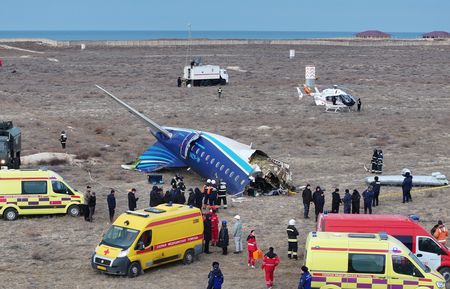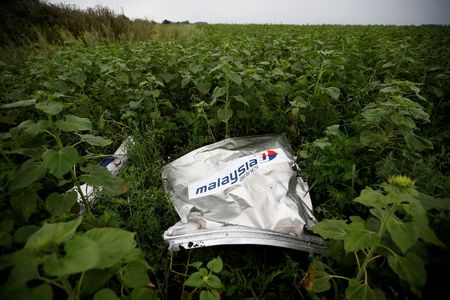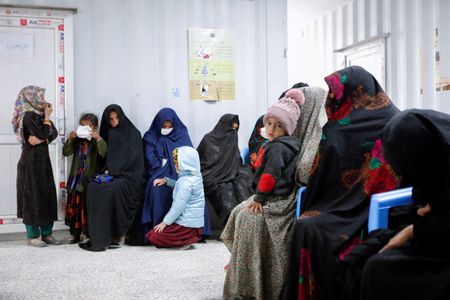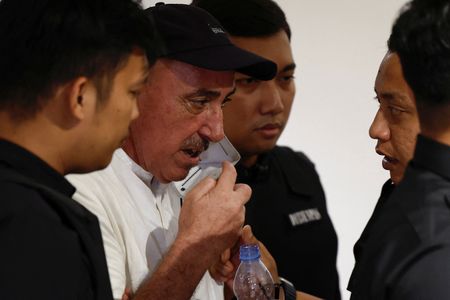ASTANA (Reuters) -An Azerbaijani passenger plane that crashed in December after being diverted from Russia to Kazakhstan had suffered external damage and was riddled with holes in its fuselage, according to a report published on a Kazakh government website on Tuesday.
Thirty-eight people were killed when the Azerbaijan Airlines passenger plane crashed on Dec. 25 near the city of Aktau in Kazakhstan after re-routing across the Caspian Sea from southern Russia.
Azerbaijan’s President Ilham Aliyev said in December the plane had been damaged by accidental shooting from the ground in Russia. Moscow has not confirmed this.
Following the crash, Russian President Vladimir Putin issued a rare apology to Aliyev for the “tragic incident” in Russian airspace, but the Kremlin did not say Russia had fired at the plane, only noting that a criminal case had been opened.
The preliminary report was issued under global aviation rules designed to draw lessons to prevent future accidents, rather than assigning blame or liability.
It was cautiously worded and did not say what had caused the extensive damage to the plane, including its stabilisers, hydraulics and trim systems.
But it included photographs showing the port side of the tail section was punctured with numerous holes. Also pictured were fragments that it described as “foreign metal objects” removed from the left stabiliser and hydraulic system.
A senior Azerbaijani government official told Reuters that the external impact referred to in the report was from a Russian surface-to-air missile.
“The Azerbaijani side possesses a fragment of a Pantsir-S missile, which was extracted from the aircraft and identified through international expertise,” the source said.
It was the first time that a Baku government source has claimed to have physical proof that Russia shot down the plane, a Brazilian-manufactured Embraer E190. No comment was immediately available from Russian officials late on Tuesday evening.
Russia says it has assigned its own investigation to the most experienced experts and that actions are being taken to establish the cause and circumstances of the incident.
‘PASSENGERS ARE LOSING CONSCIOUSNESS’
The plane had been flying from Baku to Grozny in southern Russia, where the Kremlin said Ukrainian drones had been attacking several cities at the time.
Twenty-nine people survived the crash-landing in Kazakhstan. Aliyev has hailed the pilots, who died, as national heroes. The Azerbaijani leader has said that blame lies with Russian individuals, and that Baku demands justice.
The report said that at the start of the incident, the cockpit voice recorder identified the sound of two impacts in the space of 25 seconds. Two minutes later, the pilot reported to air traffic control that he thought the plane had suffered a bird strike.
After a further five minutes, he said the aircraft was losing control.
Several other airports were discussed as possible landing sites for the stricken plane before the crew decided to head to Aktau in Kazakhstan, which required them to fly east across the Caspian Sea.
“So, we have this situation, oxygen is running out in the passenger cabin, which means an oxygen tank exploded there, I think,” the pilot reported. “So there is a smell of fuel, some passengers are losing consciousness, give us permission to go at a lower altitude.”
The plane transmitted a distress signal while approaching Aktau. It collided with the ground there an hour and 12 minutes after the pilots first reported a problem.
Azerbaijan’s transport ministry, commenting on the report, said the plane had been fully airworthy but was damaged due to the impact of “external objects”.
It highlighted the report’s finding that it was not until eight minutes after the initial impacts that Russian air traffic controllers initiated a protocol that bans aircraft from flying in areas which are being subjected to drone attacks.
(Reporting by Nailia Bagirova, Gleb Stolyarov, Tim Hepher and Tamara Vaal; writing by Mark Trevelyan, Editing by William Maclean)









